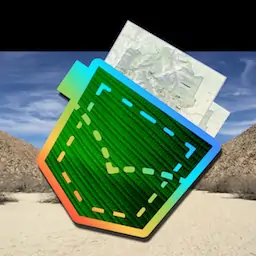"Coastal view, Cabrillo National Monument, 2015." by U.S. National Park Service , public domain
Geology Field GuideCabrillo |
Geology Field Guide for Cabrillo National Monument (NM) in California. Published by the National Park Service (NPS).
featured in
| National Parks Pocket Maps |  | |
| California Pocket Maps |  |
source
CNM Geology Guide
How Point Loma Was Formed & Geologic Features
Step 1~76 Million Years Ago
An underwater current
created fan-shaped
deposits of sand, mud, and
gravel on the ocean floor.
For millions of years these
deposits, called alluvial
fans, compacted and
layered one on top of
another. These layers are
the ground you are walking
on today!
Step 2~2 Million Years Ago
The Earth’s crust is made of
plates fractured with fault
lines. These faults move
(plate tectonics) and
cause geologic events such
as earthquakes. Plates
sometimes bunch up
against each other which
can create new formations.
Bunching in this region of
San Diego forced the
bottom of the ocean
upwards and above the
surface, exposing the
sediment from the alluvial
fan. This movement created
the Point Loma Peninsula.
Step 3–Current Day
Forces are still at work on
the peninsula! Waves carve
the sandstone shore and
erode the cliffs, and water
moves sand toward the
beach. Wind forms dunes
and beach ridges on the
top of sea cliffs. Plate
tectonics are still forcing the
peninsula to rise about 5
inches every 1,000 years!
Lindavista
Fm.
Point
Loma
Fm.
Cabrillo
Fm.
Bay
Point
Fm.
The Point Loma peninsula consists of four major
formations that were created in different ways. The
Point Loma and Cabrillo formations represent
layers from different parts of the alluvial fan. The
Bay Point Fm. and the Linda Vista Fm. however,
are the products of continuous plate tectonic
movement and erosion caused by waves.
Alluvial Fan Deposits
Sandstone
Alluvial fans are blankets of gravity-deposited
sediment under the ocean. If we drained the ocean,
the alluvial fan that created the Point Loma Peninsula
might look something like this.
Sandstone is made of layers of sediment deposited
by alluvial fans and compressed over time to make
stone. Because it’s made of sand it erodes (breaks
away) easily – be careful climbing around the cliffs!
Fissure (Cracks)
Marker/Bolt
Cracks such as these were created when the
peninsula was uplifted and tilted by plate tectonics.
These metal bolts are used in biological surveys. The
bolts enable scientists to return to the same location
year after year for long-term monitoring programs.
Inoceramid
Concretion
Concretions are geologic features that are created
much like a pearl: they start with seed material, such
as a shell, then layers of calcium carbonate build
around it, continuing to layer and harden over time.
This true fossil is that of a large, thin bivalve (2-shelled
animal) called an Inoceramid. These relatives of
modern-day clams went extinct near the end of the
Cretaceous period, around 65 million years ago.
Trace Fossils
Trace fossils are fossilized tunnels that were made by animals as they searched for food in the sand.
The left trace fossil was created by a relative of modern-day sea urchins, the right two trace fossils were created
by relatives of modern-day shrimp.


